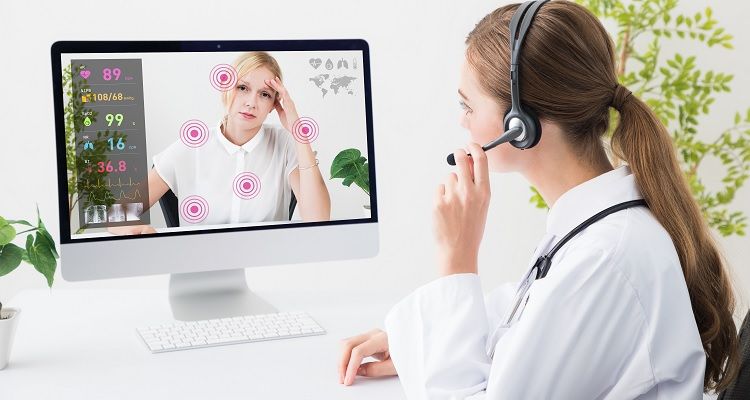Advancements in digital technology continue to increase patient care options. One of the most transformative is telehealth as an alternative to standard in-office care. Understanding the importance of this health innovation and developing knowledge and skills with the application of telehealth technology is essential for the family nurse practitioner (FNP).
Nurses seeking a Post-Master’s Certificate in Family (Individual Across the Lifespan) Nurse Practitioner from Duquesne University use modern technology to connect and learn. The FNP curriculum can provide APRNs with the skills to offer quality healthcare both in person and via technology. Students who receive post-master’s FNP online certification gain the important skill sets needed to be a competitive provider of telehealth services.

What Is Telehealth, and How Does It Affect the Nursing Profession?
Telehealth refers to using technology to deliver healthcare services. That technology can include electronic information, devices and telecommunication technology and can include either direct or remote patient service.
According to the Mayo Clinic, examples of potential telehealth services include an online portal that allows the patient to review test results and request prescription refills. Another example allows the patient to log in for a virtual appointment, answer a series of questions through a web-based provider and then receive from the telehealth nurse suggested home-care strategies or prescribed medicines.
Telehealth, once considered an impersonal delivery method of patient care, has emerged as a cost-effective, quality alternative to the in-office visit.
Some of the documented benefits of telehealth care include decreased provider costs attributed to lower re-admission rates and improved management of chronic diseases. The technology also allows nurse practitioners to expand their reach by providing care to patients in remote locations and deliver services to those who have difficulty traveling.
For FNPs practicing telehealth, the positives are well documented. Ruth Kleinpell, RN, PhD, ARPN-BC, CCRN, et al., surveyed more than 1,200 nurses to gauge perceptions of intensive care telemedicine. Their work, detailed in “Assessing the Impact of Telemedicine on Nursing Care in Intensive Care Units” in the American Journal of Critical Care, found that the use of telehealth leads to:
- Improved collaboration
- Increased job performance
- Enhanced accomplishment of tasks
- Improved communication
- Streamlined nursing assessments
- Increased time allotted for patient care
Important Considerations When Using Telehealth
When choosing to offer remote care, telehealth nurses should consider parameters outlined by Carolyn M. Rutledge et al., in a 2017 study in Advances in Medical Education Practices. Those parameters include:
- Become familiar with telehealth etiquette
Interaction via telehealth requires different behaviors than an inpatient visit. The majority of consultations use video-conferencing, so camera position should be properly maintained, all distracting background items moved out of range and neutral clothing worn on-camera. During the consultation, eye contact should be level with the camera lens, while body language and word selection should emote empathy as needed.
- Capitalize on the expansion of inter-professional collaboration
Interacting with colleagues when providing patient care is no longer limited to face-to-face interaction. Technology allows nurse practitioners to collaborate and consult with colleagues globally in real-time.
- Be aware of the regional variations in regulations
Practicing telehealth often results in nurse practitioners providing care across state lines. The variation of state laws can affect delivery of services. However, a 2017 study by the American Telemedicine Association (ATA) found that states are “removing unnecessary requirements” and “providing healthcare practitioners increased opportunities to practice across state lines.”
- Examine reimbursement procedures for insurance
The acceptance of telehealth services by insurance providers continues to grow. The ATA’s 2017 Coverage and Reimbursement report found that for the first time since the report’s inception in 2014, all Medicaid agencies “cover some form of telemedicine.” In 2017, “all states allow coverage of telemedicine to some degree compared to 24 states in 2005.” A telehealth nurse should thoroughly research applicable state laws.
- Understand security requirements of the Health Insurance Portability and Accountability Act of 1996 (HIPAA)
Security requirements for nurse practitioners providing telehealth fall under the HIPAA guidelines established in 1996. Beyond protecting personal information transmitted electronically, the telehealth provider is responsible for securing both the origination site and distant site, as well as any transmissions between the two places of service. All electronic communication requires both proper encryption of patient data as well as the distribution of HIPAA agreements to all personnel providing tech services.
Evaluate potential ethical concerns
The model of delivery for telehealth services “can trigger interesting ethical challenges for providers,” according to Rutledge. Those challenges include “erosion of the patient/provider relationship, threats to patient privacy, forcing one-size-fits-all implementations and the temptation to assume that the new technology must be effective.” Addressing those concerns should be done at the nursing curriculum level so that a provider “possesses the moral sensitivity to identify ethical issues in care regardless of the structure and format of the interaction.”
The delivery model also raises concerns about the potential for patients to abuse the system by shopping for providers who will provide desired prescriptions. Because of this concern, Rutledge writes, a “close review and understanding of the laws and regulations that govern provider scope of practice” is imperative.
The rapid growth of technology combined with the accelerated acceptance of telehealth has resulted in a new level of expectation in patient care. Learning through Duquesne University’s online classroom helps the FNP offer better healthcare both in person and via technology.
About Duquesne’s Post-Master’s FNP Certificate
Duquesne University’s online Post-Master’s Certificate in Family (Individual Across the Lifespan) Nurse Practitioner includes essential clinical hours geared toward preparedness for both national certification exams and licensure. The online coursework offers FNPs the skills to deliver quality healthcare services both in person and via technology. For more information, visit the Duquesne University online website.
- https://www.mayoclinic.org/healthy-lifestyle/consumer-health/in-depth/telehealth/art-20044878
- https://www.medscape.com/viewarticle/858679
- https://www.ncbi.nlm.nih.gov/pmc/articles/PMC5498674/
- https://thesource.americantelemed.org/blogs/jessica-washington/2017/02/09/latest-industry-report-identifies-best-states-for-telemedicine

